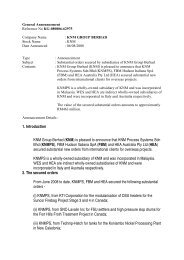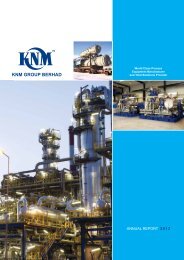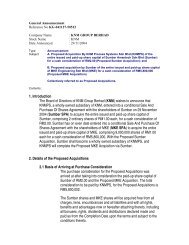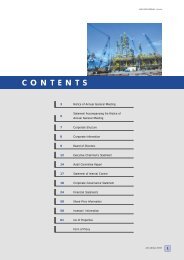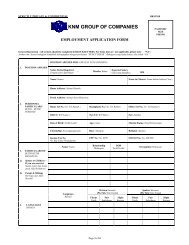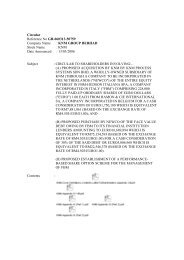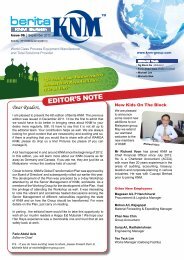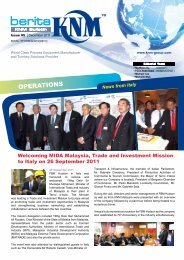ANNUAL REPORT 2008 - KNM Steel Sdn Bhd
ANNUAL REPORT 2008 - KNM Steel Sdn Bhd
ANNUAL REPORT 2008 - KNM Steel Sdn Bhd
Create successful ePaper yourself
Turn your PDF publications into a flip-book with our unique Google optimized e-Paper software.
NOTES TO THE<br />
FINANCIAL STATEMENTS (CONT’D)<br />
2. Significant accounting policies (cont’d)<br />
(l)<br />
Impairment of assets (Cont’d)<br />
The recoverable amount of an asset or cash-generating unit is the greater of its value in use and its fair<br />
value less costs to sell. In assessing value in use, the estimated future cash flows are discounted to their<br />
present value using a pre-tax discount rate that reflects current market assessments of the time value<br />
of money and the risks specific to the asset. For the purpose of impairment testing, assets are grouped<br />
together into the smallest group of assets that generates cash inflows from continuing use that are<br />
largely independent of the cash inflows of other assets or groups of assets (the “cash-generating unit”).<br />
The goodwill acquired in a business combination, for the purpose of impairment testing, is allocated to<br />
cash-generating units that are expected to benefit from the synergies of the combination.<br />
An impairment loss is recognised if the carrying amount of an asset or its cash-generating unit exceeds<br />
its recoverable amount unless the asset is carried at a revalued amount, in which case the impairment<br />
loss is recognised directly against any revaluation surplus for the asset to the extent that the impairment<br />
loss does not exceed the amount in the revaluation surplus for that same asset. Impairment losses are<br />
recognised in the income statements. Impairment losses recognised in respect of cash-generating units<br />
are allocated first to reduce the carrying amount of any goodwill allocated to the units and then to reduce<br />
the carrying amount of the other assets in the unit (groups of units) on a pro rata basis.<br />
An impairment loss in respect of goodwill is not reversed. In respect of other assets, impairment losses<br />
recognised in prior periods are assessed at each reporting date for any indications that the loss has<br />
decreased or no longer exists. An impairment loss is reversed if there has been a change in the estimates<br />
used to determine the recoverable amount. An impairment loss is reversed only to the extent that the<br />
asset’s carrying amount does not exceed the carrying amount that would have been determined, net<br />
of depreciation or amortisation, if no impairment loss had been recognised. Reversals of impairment<br />
losses are credited to the income statements in the year in which the reversals are recognised, unless<br />
it reverses an impairment loss on a revalued asset, in which case it is credited directly to revaluation<br />
surplus. Where an impairment loss on the same revalued asset was previously recognised in the income<br />
statements, a reversal of that impairment loss is also recognised in the income statements.<br />
(m)<br />
Equity instruments<br />
All equity instruments are stated at cost on initial recognition and are not re-measured subsequently.<br />
(i)<br />
Issue expenses<br />
Incremental costs directly attributable to issue of equity instruments are recognised as a deduction<br />
from equity.<br />
(ii)<br />
Repurchase of share capital<br />
When share capital recognised as equity is repurchased, the amount of the consideration paid,<br />
including directly attributable costs, is recognised as a deduction from equity and is not re-valued<br />
for subsequent changes in the fair value or market price of shares. Repurchased shares are<br />
classified as treasury shares and are presented as a deduction from total equity.<br />
Where treasury shares are distributed as share dividends, the cost of the treasury shares is applied<br />
in the reduction of the share premium account or distributable reserves, or both.<br />
Where treasury shares are reissued by re-sale in the open market, the difference between the<br />
sales consideration net of directly attributable costs and the carrying amount of the treasury shares<br />
is recognised in equity.<br />
<strong>KNM</strong> GROUP BERHAD<br />
69<br />
<strong>ANNUAL</strong> <strong>REPORT</strong> <strong>2008</strong>





